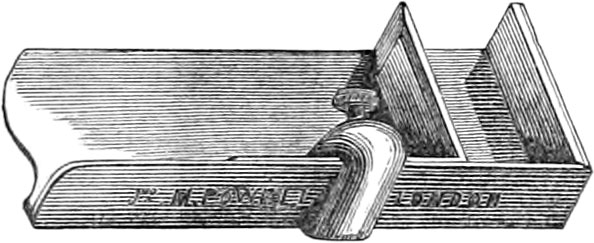Composing stick
An instrument in which letters are set, or arranged in lines. They are made of various designs, and the illustrations annexed represent two of the most modern.


Composing Sticks of the old-fashioned makes consist of the following parts: The plate which forms the bed of the instrument; the flanch, turned up from the plate at right angles, and ⅝ths of an inch high above the plate, through which are bored holes, about one inch apart from each other, to receive the screw; the head, which is of the same height as the flanch, but much stronger, securely fastened to it and the plate by rivets, dovetail, or brazing; the slide, having an opening in the lower leg, or part which rests against the flanch, to admit the tenon of the nut, which is shouldered to fit into this groove, and which nut is to receive the screw on its being passed through one of the holes, to fasten the slide to any measure that may be required. This is done by means of the groove in the slide being moved backward or forward on the screw and nut, and by the screw being used at the hole convenient to the distance required, so as to set the slide at the point wanted from the head.
The descriptions of Composing Sticks figured in our woodcuts are made to obviate the necessity of perforating the flanch; the slide being fixed to the desired distance from the head, in the one case by a screw, and in the other by a lever, so arranged as to grasp tightly the slide and the flanch. The chief advantage of this arrangement is, that an alteration of measure can be made with the utmost facility.
Composing Sticks are made of iron, brass, or gun-metal; the latter, owing to their not being liable to corrosion, are the most suited for warm climates. They are made of various lengths, from about four inches up to ten or twelve; above that size, for broadsides, they are chiefly made of mahogany. Sometimes the side is split, and when the two parts are put asunder, they can be adjusted to a short measure, so that the compositor can have his work proceeding in two different measures at one time, without altering his stick.
The depth of English sticks is about two inches, but in France they are much shallower, frequently holding no more than six lines. The most usual defects in Composing Sticks are, the slides and heads not being perfectly square to each other, and each of them to the plate; also, the slides and heads are sometimes not square, or at right angles to the flanch.
Composing stick
An instrument in which letters are set, or arranged in lines. Composing-sticks of the old-fashioned makes consist of the following parts: The plate which forms the bed of the instrument; the flanch, turned up from the plate at right angles, and five-eighths of an inch high above the plate, through which are bored holes, about one inch apart from each other, to receive the screw; the head, which is of the same height as the flanch, but much stronger, securely fastened to it and the plate by rivets, dovetail, or brazing; the slide, having an opening in the lower leg, or part which rests against the flanch, to admit the tenon of the nut, which is shouldered to fit into this groove, and which nut is to receive the screw on its being passed through one of the holes, to fasten the slide to any measure that may be required. This is done by means of the groove in the slide being moved backward or forward on the screw and nut, and by the screw being used at the hole convenient to the distance required, so as to set the slide at the point wanted from the head.
Some descriptions of Composing-sticks are made to obviate the necessity of perforating the flanch; the slide being fixed from the desired distance from the head by a screw or by a lever, so arranged as to grasp tightly the slide and the flanch. The chief advantage of this arrangement is, that an alteration of measure can be made with the utmost facility.
Composing-sticks are made of iron, brass, or gun-metal; the latter, owing to their not being liable to corrosion, are the most suited for warm climates. They are made of various lengths, from about four inches up to ten or twelve; above that size, for broadsides, they are chiefly made of mahogany. Sometimes the side is split, and when the two parts are put asunder, they can be adjusted to a short measure, so that the Compositor can have his work proceeding in two different measures at one time, without altering his stick.
The depth of English sticks is about two inches, but in France they are much shallower, frequently holding no more than six lines. The most usual defects in Composing-sticks are, the slides and heads not being perfectly square to each other, and each of them to the plate; also, the slides and heads are sometimes not square, or at right angles to the flanch.